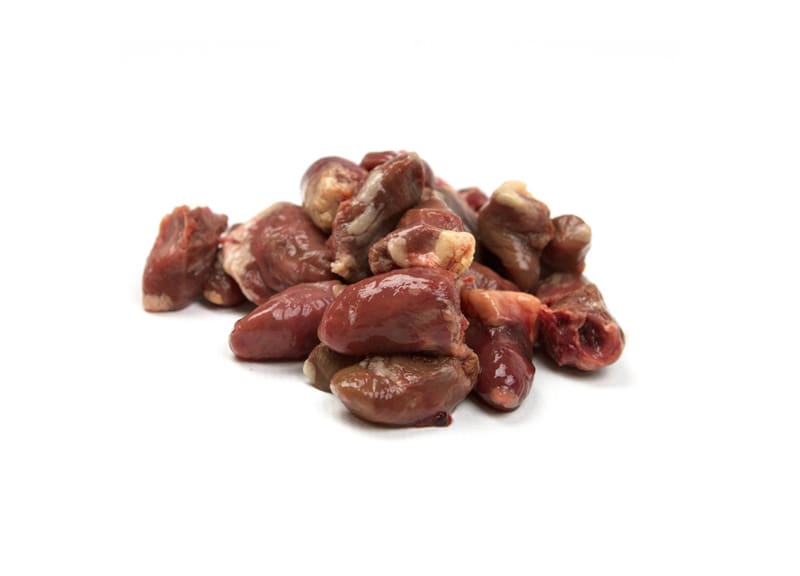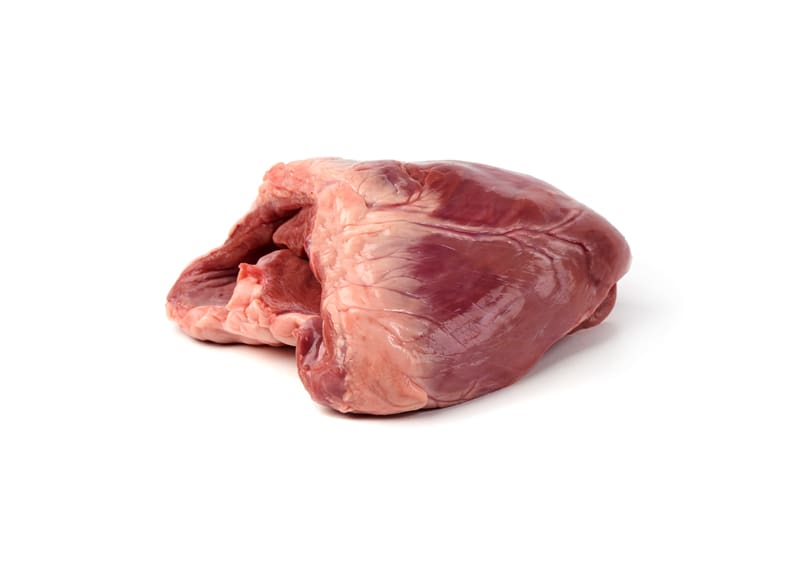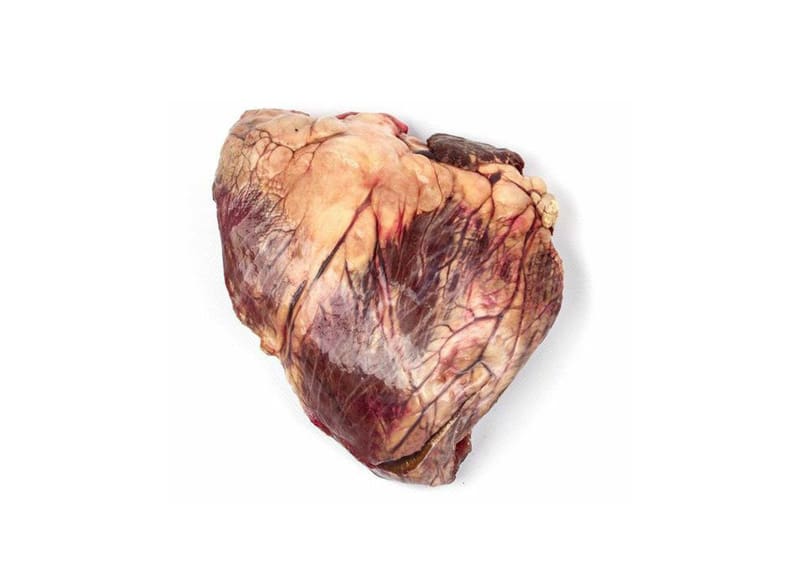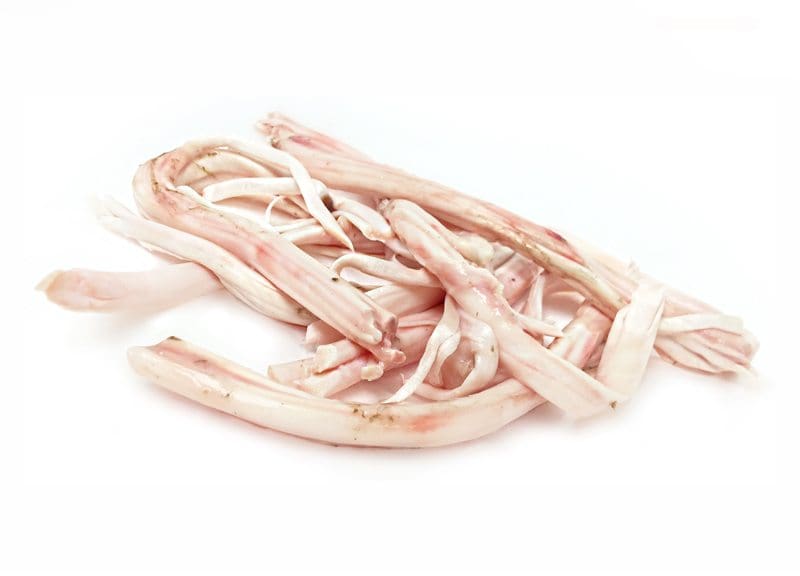Muscle meat is the primary component of a raw diet and is essential for a complete and balanced diet. The term “muscle meat” includes ingredients other than boneless muscle meat. Some items are easy to identify, but others may be difficult. Do not get caught up in commercial names for meat and meat-like items because they differ from raw feeding classifications.
There are many ingredients that may cause confusion on their classification because of terminology differences between biology definitions and the meat industry terms. Muscle meats have biological functions within the body and do not secrete fluids needed for biological functions like secreting organs do. In raw diets, the muscle meat category encompasses many ingredients based on their functions.
Boneless Muscle Meat
The primary ingredient is boneless muscle meat.
Raw Animal Fat
Raw animal fat is included in the muscle meat category.
Animal Tongue
Animal tongues are a source of boneless muscle meat and raw animal fat.
Heart
The heart is a muscular organ and is fed as muscle meat in raw diets.
Green Tripe
Unbleached, green tripe is the stomach muscle lining in ruminant animals.
Lungs
Lungs are a muscular organ and are fed as muscle meat in raw diets.
Gizzards
Gizzards are the mechanical stomach in poultry and fowl animals.
Connective Tissues
Cartilage, tendons, and other connective tissues are fed as muscle meat.
Puppies, dogs, and cats have protein requirements to provide amino acids for optimal health. Raw diet ratios include 60-80% muscle meat which is the main source of protein, but also provides other essential nutrients such as water-soluble vitamins and minerals.
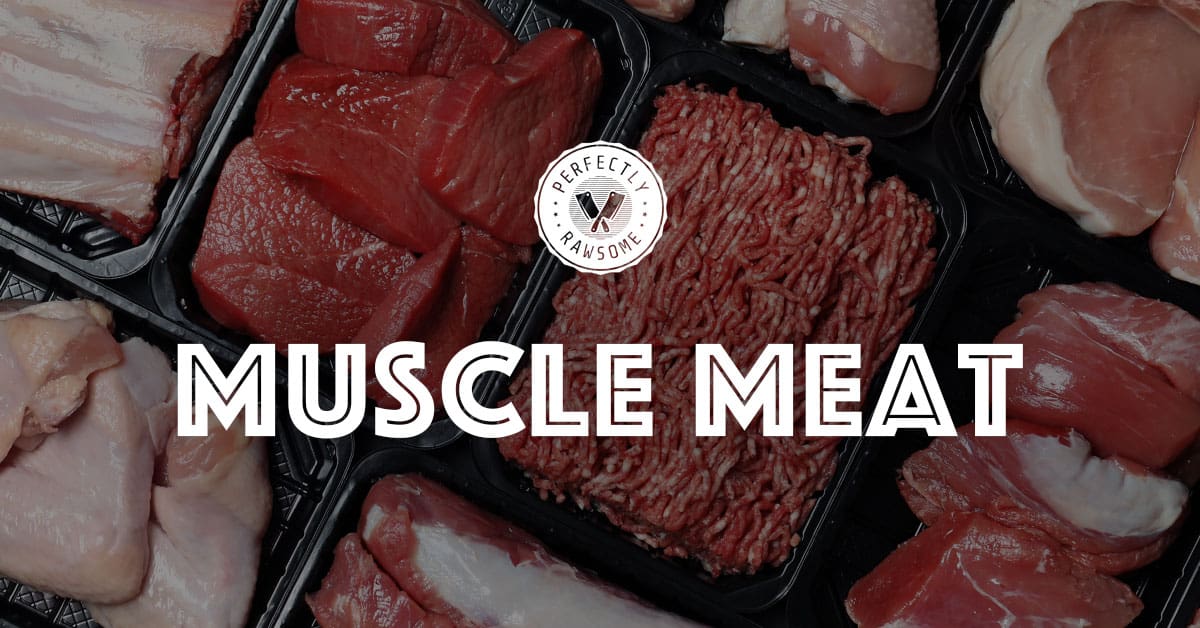
Boneless Muscle Meat
One of the easiest and most obvious ingredients for meat includes boneless muscle meat. Raw, boneless muscle meat is the main source of protein in raw diets. Muscle meat is further segmented into white and red meat. The classification of white and red meat are based on the type of fibers muscle tissue is made of. There are fast twitch (white meat) and slow twitch (red meat) muscle fibers.
White Meat Proteins
Chicken
Turkey
Domestic Rabbit
Quail
Cornish Hen
Red Meat Proteins
Duck
Pork
Beef
Lamb
Wild Game
White meat is lighter due to low concentrations of myoglobin in the muscle tissue because fast twitch fibers do not require oxygen to produce energy for muscle contractions.
Red meat is darker due to higher amounts of myoglobin present in the muscle tissue because slow twitch fibers require a rich supply of oxygenated blood to produce sufficient energy for prolonged muscle contractions.
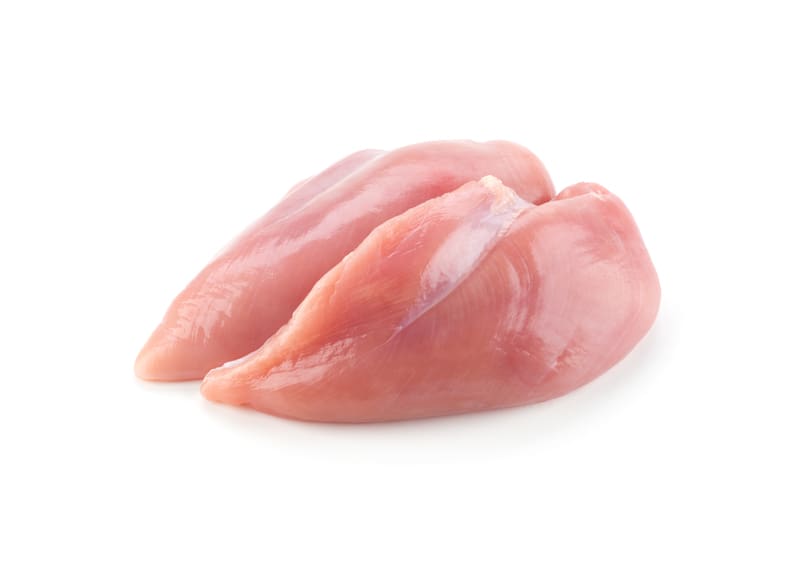
Chicken Muscle Meat
The amount of calories, protein, fat, and carbs are based on 1oz (28g).
| Moisture | 74% |
| Protein | 22% |
| Fat | 2.6% |
| Carbohydrate | 0% |
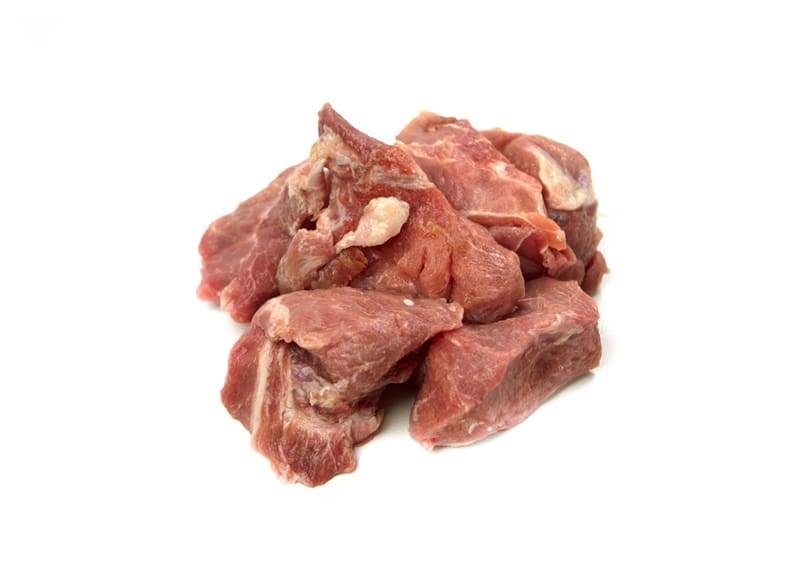
Pork Muscle Meat
The amount of calories, protein, fat, and carbs are based on 1oz (28g).
| Moisture | 67% |
| Protein | 19.7% |
| Fat | 12.6% |
| Carbohydrate | 0% |
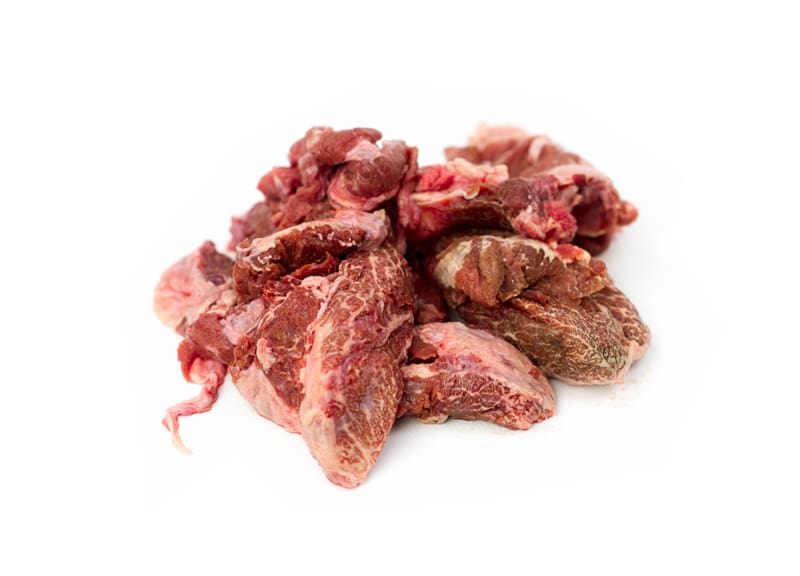
Beef Muscle Meat
The amount of calories, protein, fat, and carbs are based on 1oz (28g).
| Moisture | 72.8% |
| Protein | 22% |
| Fat | 4% |
| Carbohydrate | 0% |
Overall, red meat proteins are more nutritious than white meat proteins. Red meats provide more protein, fats, minerals, and water-soluble vitamins in comparison to white meat proteins. However, red meat is more expensive than white meat. It is best to feed a minimum of 50% red meat in a raw diet.
Muscle Meat Variety
There are many other boneless muscle meat proteins that were not covered, but this does not mean they are not suitable and safe options for raw diets. Additionally, the nutritional information on many exotic meats is unavailable to have an accurate assessment on macro and micro nutrients.
Raw Animal Fat
In addition to boneless muscle meat, raw animal fat falls under the meat category in raw diets. Dogs and cats require fat for sufficient levels of energy for physical activity and metabolic processes.
Boneless muscle meat and raw meaty bones (RMB) naturally provide raw fat depending on the protein option. Some muscle meats are very lean, with little to no fat, and other meats include higher amounts of fat.
Lean Proteins
Chicken & Turkey
Domestic Rabbit
Wild Game
Fatty Proteins
Pork
Beef
Lamb
Raw diets made with lean proteins require an additional fat source added into meals to ensure sufficient levels of fat for energy. Sourcing raw animal fat from fatty proteins is an ideal way to increase fat in lean meals or for highly active pets.
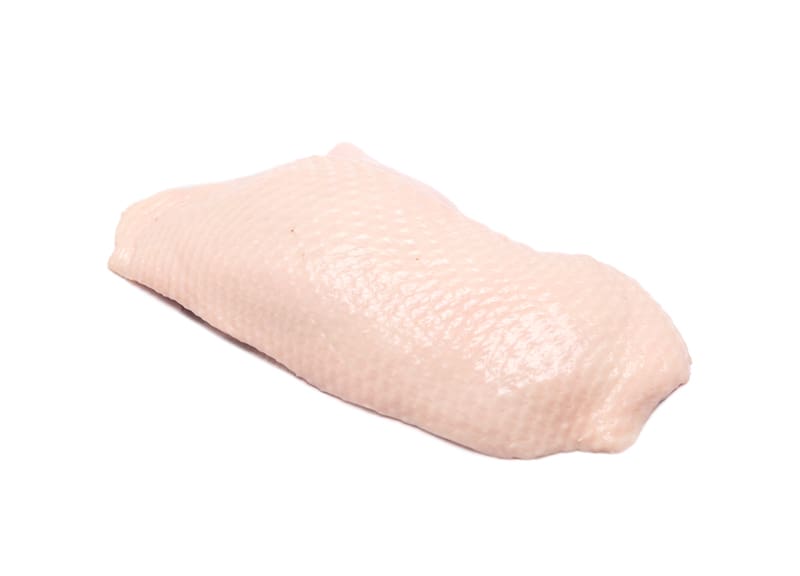
Chicken Skin & Fat
The amount of calories, protein, fat, and carbs are based on 1oz (28g).
| Moisture | 54% |
| Protein | 13% |
| Fat | 32% |
| Carbohydrate | 0% |

Pork Jowls
The amount of calories, protein, fat, and carbs are based on 1oz (28g).
| Moisture | 22% |
| Protein | 6% |
| Fat | 69.6% |
| Carbohydrate | 0% |

Beef Fat
The amount of calories, protein, fat, and carbs are based on 1oz (28g).
| Moisture | 20% |
| Protein | 8% |
| Fat | 70.8% |
| Carbohydrate | 0% |
Fat has a bad rap and many fail to realize it is a vital component to optimal canine health. Contrary to common belief, fat does not equate to weight gain if the appropriate amount is fed for individual needs without overdoing calories and raw fat is not unhealthy or dangerous.
It is a popular misconception that fat causes pancreatitis in dogs and cats. However, this is not exactly the case in raw diets when appropriate amounts of animal fats are fed in a low carbohydrate diet. Additionally, cooked fats are of concern for dogs and cats.
This is because the act of cooking, particularly with high heat, transforms fats, they oxidize, and become carcinogenic. When high fats, particularly cooked fats, is pared with high carbohydrates, it is a toxic concoction which is excessively stressful on a carnivore’s pancreas. Ultimately, this results in pancreatitis.
Fat Variety
Be sure to feed raw animal fats and avoid cooked animal fats which can cause digestive upset and even pancreatitis. There are many other raw fat options that were not covered, but this does not mean they are not suitable and safe options for raw diets.
Tongue
The tongue of an animal is one large muscle and can be fed as boneless muscle meat for protein and raw fat. In addition to providing protein, raw tongue is fatty muscle meat with a 1:1 protein to fat ratio.
Raw tongue is a good ingredient option for highly active pets and raw keto diets because of the amounts of raw fat it contains. One downside to raw tongue is cost as tongue meat is considered a delicacy in many cultures.

Beef Tongue
The amount of calories, protein, fat, and carbs are based on 1oz (28g).
| Moisture | 64.5% |
| Protein | 14.9% |
| Fat | 16.1% |
| Carbohydrate | 0% |
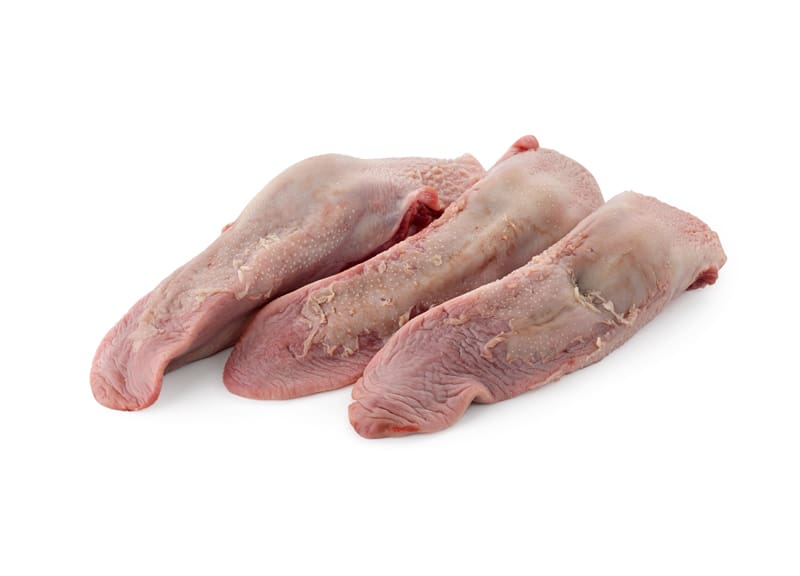
Pork Tongue
The amount of calories, protein, fat, and carbs are based on 1oz (28g).
| Moisture | 65.9% |
| Protein | 16% |
| Fat | 17% |
| Carbohydrate | 0% |
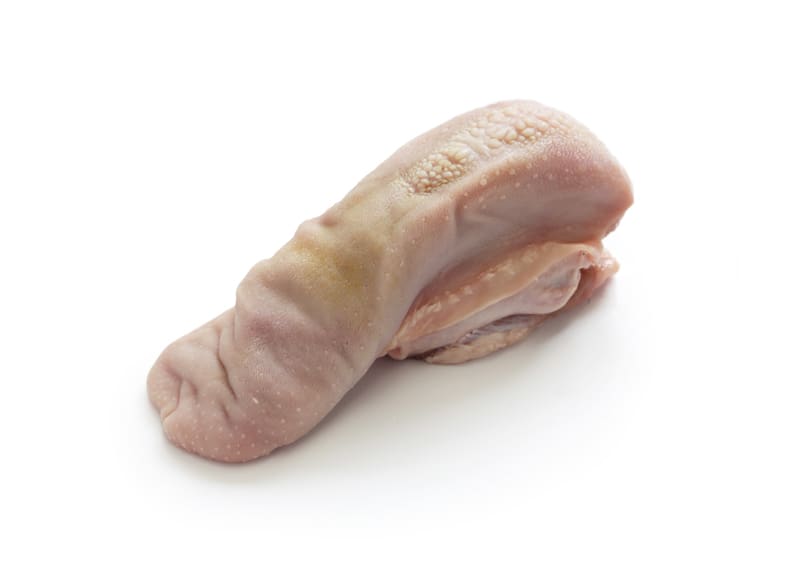
Lamb Tongue
The amount of calories, protein, fat, and carbs are based on 1oz (28g).
| Moisture | 66.6% |
| Protein | 15.7% |
| Fat | 17% |
| Carbohydrate | 0% |
Raw Tongue Variety
There are many other tongue proteins that were not covered, but this does not mean they are not suitable and safe options for raw diets. Additionally, the nutritional information on many exotic options is unavailable to have an accurate assessment on macro and micro nutrients.
Heart
Often classified as an organ, raw heart is a muscular organ and is fed as a lean muscle meat in raw diets. Out of the meat category, it is recommended that 10-15% includes raw heart. Raw heart provides protein, but contains high levels of B vitamins and minerals.
Chicken Heart
The amount of calories, protein, fat, and carbs are based on 1oz (28g).
| Moisture | 73.6% |
| Protein | 15.6% |
| Fat | 9.3% |
| Carbohydrate | 0% |
Pork Heart
The amount of calories, protein, fat, and carbs are based on 1oz (28g).
| Moisture | 76% |
| Protein | 17% |
| Fat | 4% |
| Carbohydrate | 0% |
Beef Heart
The amount of calories, protein, fat, and carbs are based on 1oz (28g).
| Moisture | 77% |
| Protein | 17.7% |
| Fat | 3.9% |
| Carbohydrate | 0% |
Heart Variety
There are many other heart proteins that were not covered, but this does not mean they are not suitable and safe options for raw diets. Additionally, the nutritional information on many exotic heart muscular organs are unavailable to have an accurate assessment on macro and micro nutrients.
Unbleached, Green Tripe
Green tripe is the stomach lining of ruminant animals such as cattle, lamb, and goats. Green tripe has a 1:1 balanced calcium to phosphorus ratio and is a good source of manganese!
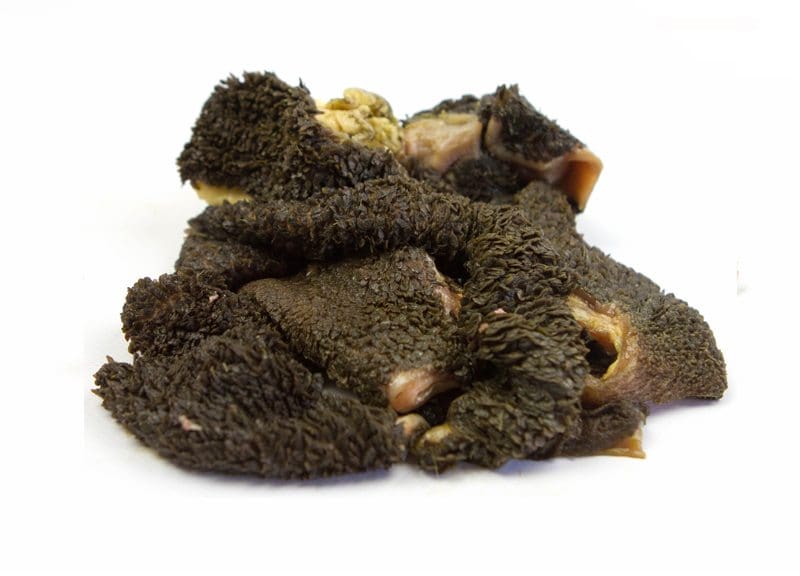
Beef Green Tripe
The amount of calories, protein, fat, and carbs are based on 1oz (28g).
| Moisture | 64.7% |
| Protein | 14.9% |
| Fat | 18% |
| Carbohydrate | 0% |
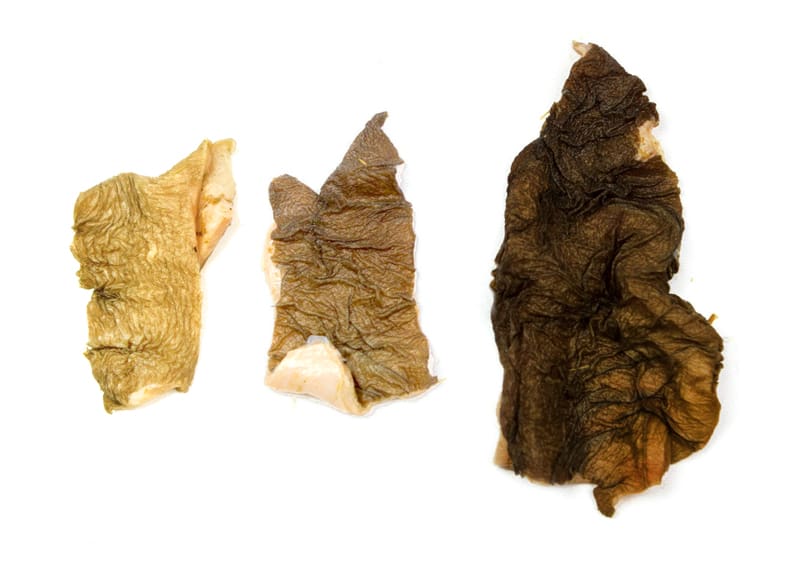
Green Tripe Shades
Green tripe comes in a variety of shades of green. The color of tripe is related to the diet the ruminant consumed. Dark green tripe is from a diet high in grass while lighter colored, yellow tinted tripe is from the inclusion of corn in the animal’s diet.
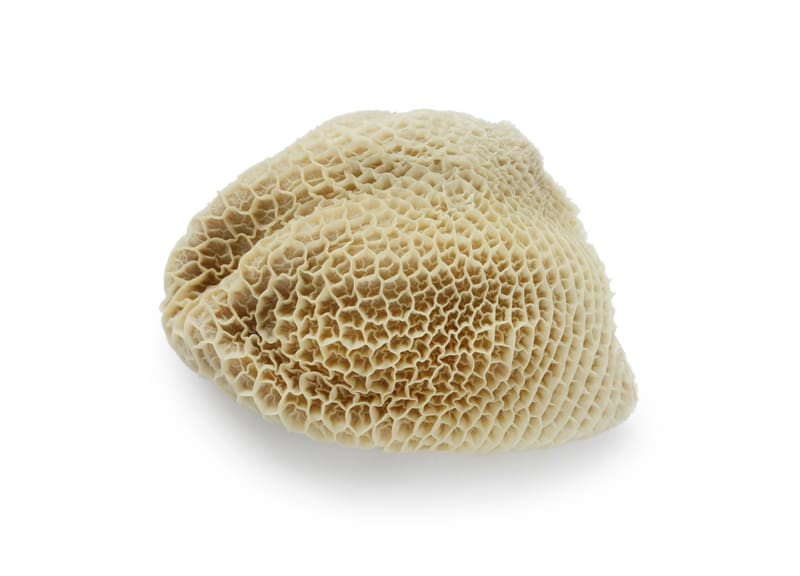
White, Bleached Tripe
White tripe is often sold in ethnic markets for human consumption which goes through a cleaning process that removes all of the beneficial nutrients green tripe provides. Therefore, it is recommended to feed green tripe.
Ruminant animals have a four chamber stomach, the rumen, the reticulum, the omasum, and the abomasum. Each one of these chambers has a different “texture” to the stomach lining. It is not uncommon to receive a variety of tripe textures when purchasing green tripe for pet consumption.
There are laws in the United States which prohibit slaughterhouses and butchers from selling green tripe to the public due to USDA and FDA regulations. Similarly, many other countries have limitations on the sale of green tripe. Typically, green tripe can only be sourced through pet food suppliers and is unobtainable in local grocery markets.
Tripe Variety
There are many other ruminant animals that provide green tripe that were not covered but this does not mean they are not suitable and safe options for raw diets. Additionally, the nutritional information on green tripe is mostly unavailable to have an accurate assessment on macro and micro nutrients.
Lungs
Similar to raw heart, raw lungs are often considered as an organ, but are a muscular organ and is fed as lean muscle meat in raw diets. Raw lungs are a good source of protein, selenium, and iron, but sourcing raw lungs can prove difficult to many raw feeders without access to ethnic markets or raw pet food suppliers.

Beef Lung
The amount of calories, protein, fat, and carbs are based on 1oz (28g).
| Moisture | 79% |
| Protein | 16% |
| Fat | 2.5% |
| Carbohydrate | 0% |
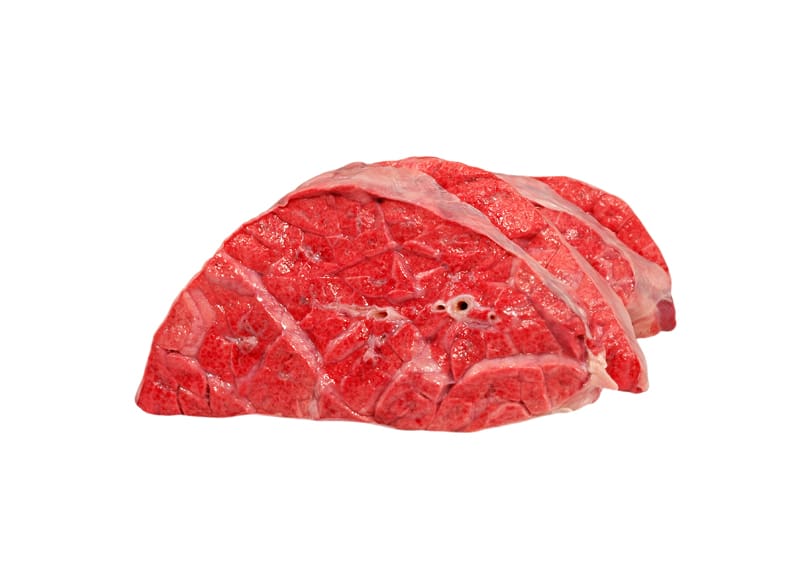
Pork Lung
The amount of calories, protein, fat, and carbs are based on 1oz (28g).
| Moisture | 79.5% |
| Protein | 14% |
| Fat | 2.7% |
| Carbohydrate | 0% |
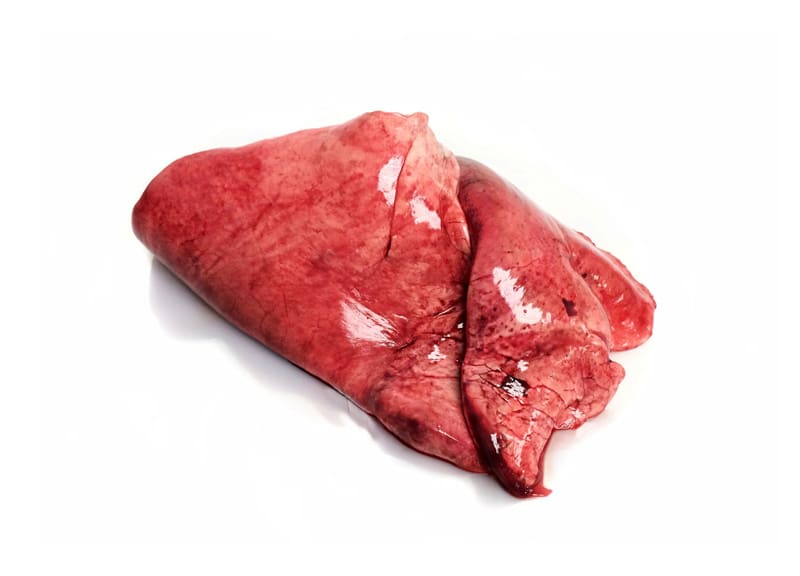
Lamb Lung
The amount of calories, protein, fat, and carbs are based on 1oz (28g).
| Moisture | 79.7% |
| Protein | 16.7% |
| Fat | 2.6% |
| Carbohydrate | 0% |
Lung Variety
There are many other lung proteins that were not covered, but this does not mean they are not suitable and safe options for raw diets. Additionally, the nutritional information on exotic lung muscular organs are unavailable to have an accurate assessment on macro and micro nutrients.
Gizzards
The gizzard (giblet) is the mechanical stomach of poultry and fowl birds. They are fed as boneless lean muscle meat in raw diets as a source of protein, but are not a crucial ingredient to creating a balanced diet. However, gizzards are relatively inexpensive and easy to source, which is useful to maintain lower monthly budget costs.
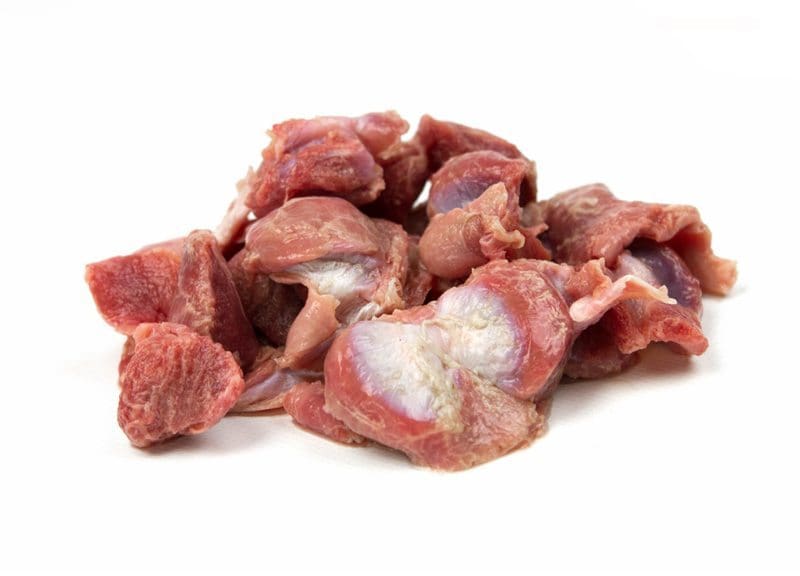
Chicken Gizzards
The amount of calories, protein, fat, and carbs are based on 1oz (28g).
| Moisture | 79% |
| Protein | 17.6% |
| Fat | 2% |
| Carbohydrate | 0% |
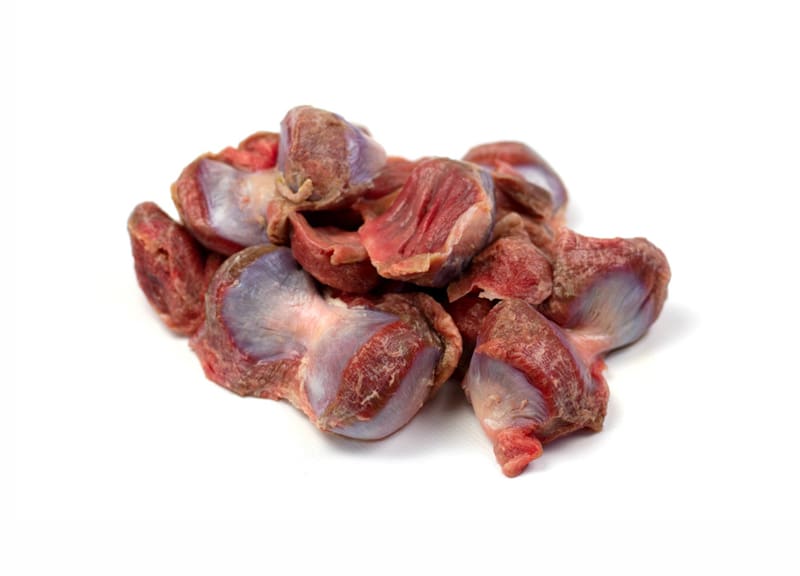
Turkey Gizzards
The amount of calories, protein, fat, and carbs are based on 1oz (28g).
| Moisture | 77% |
| Protein | 18.8% |
| Fat | 3% |
| Carbohydrate | 0% |
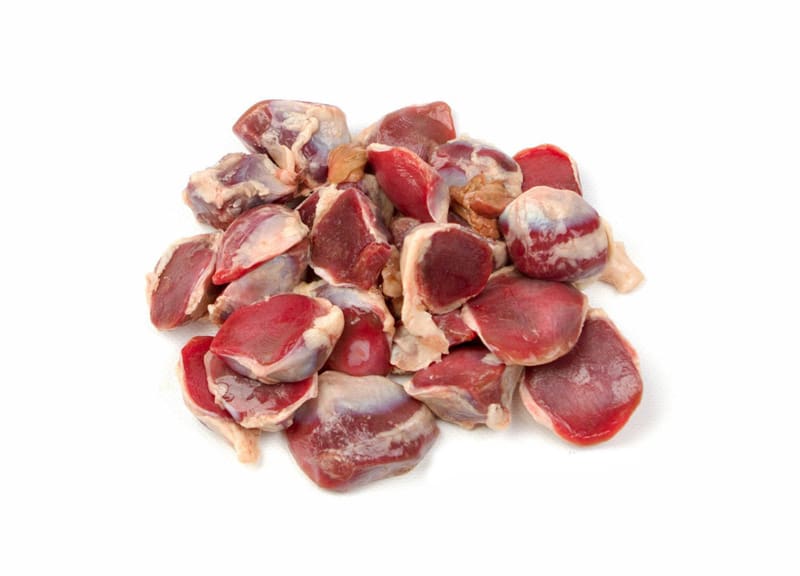
Duck Gizzards
The nutritional data on duck gizzards is unavailable. However the data from chicken and turkey gizzards can be used in place of duck gizzards for meal formulation.
Miscellaneous Muscle Meat Ingredients
The muscle meat category in raw diets encompasses many ingredients that are well known as well as uncommon items. In addition to boneless muscle meat, fat, and muscular organs include off-cut items that fall within the muscle meat category for raw diets.

Uterus
Uterus is the reproductive muscle in female animals and are fed as lean muscle meat in raw diet as a source of protein, but are not a crucial ingredient to creating a balanced diet. Uterus is another difficult ingredient to source but is typically found in ethnic markets.
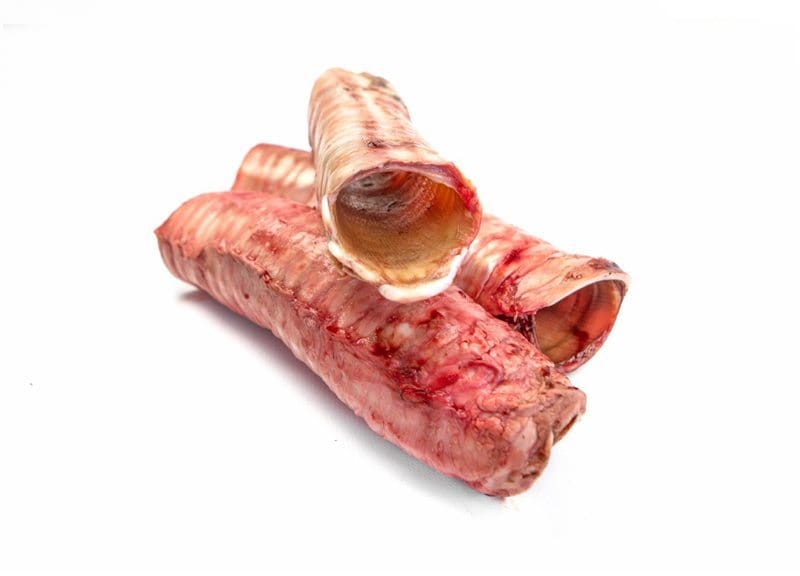
Cartilage: Trachea, Gullets, & Animal Ears
Many pet parents are familiar with dehydrated pig ears sold in pet stores, but these items provide a benefit in raw diets! Similar to dehydrated ears – raw trachea, gullets, and ears are primarily cartilage which provides high amounts of dietary chondroitin for joint support. Chondroitin is one of the main building blocks of cartilage in joints. Therefore, dogs and cats with joint issues benefit from diets that include foods with cartilage.
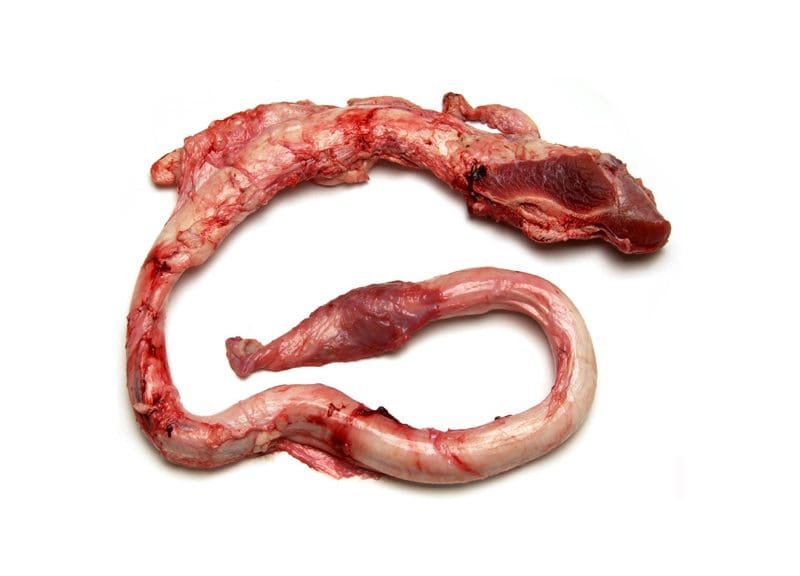
Pizzle
Pizzle (penis) is the reproductive muscle in male animals and is fed as lean muscle meat in raw diets as a source of protein, but are not a crucial ingredient to creating a balanced diet. Pizzle is another difficult ingredient to source, but is typically found in ethnic markets.
Tendons
Small tendons are often included in boneless muscle meat and raw meaty bones (RMB) because they are the connective tissues holding joints together and muscles onto bones. Tendons are another beneficial food source for pets with joint issues because tendons are a good source of collagen!
CLOSING COMMENTS
The main component of raw diets consists of muscle meat to ensure sufficient levels of protein and amino acids are provided for optimal health. Outside of boneless muscle meat and muscular organs, ingredients such as raw fat and cartilage are classified as muscle meats in raw diets.
A raw diet should have a minimum of 50% red muscle meat to provide higher levels of minerals and water-soluble vitamins for a balanced diet. Additionally, the raw diet should provide raw fat to ensure appropriate calories are provided to maintain stable and consistent energy levels.

